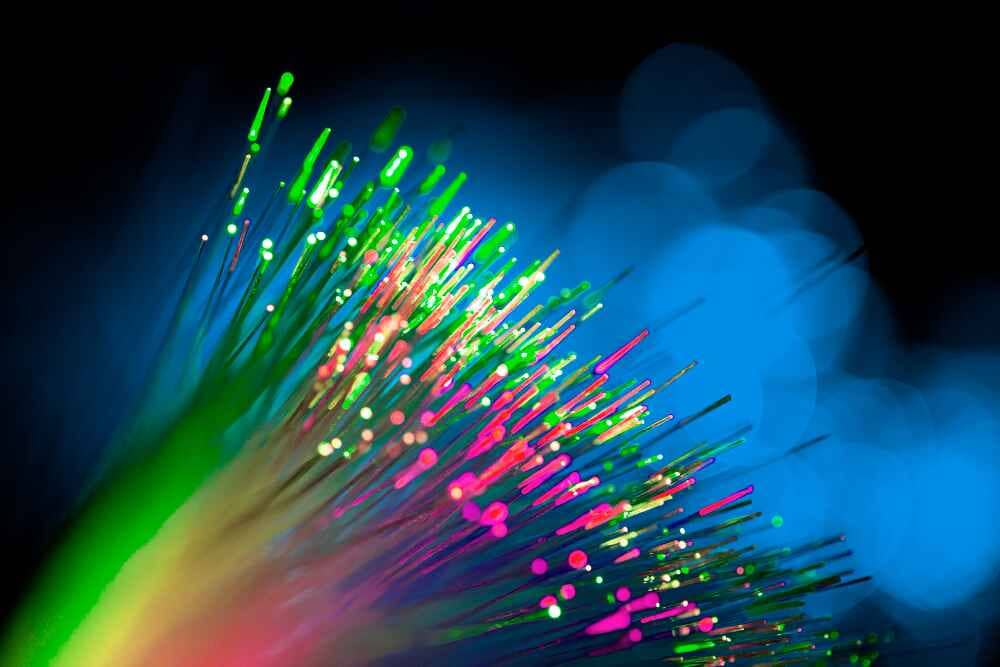Problems with Fiber Optic Internet
In today’s digital age, internet connectivity is fundamental to almost every aspect of our lives, from work to leisure. Among the various options available, fiber optic internet has emerged as a game-changer, offering unparalleled speed and reliability. Its widespread adoption globally has reshaped how we connect and interact online.
Benefits of Fiber Optic Internet:
Fiber optic internet brings a host of benefits that have fueled its popularity among users and businesses alike:
1. High-Speed Connectivity: Fiber optic cables transmit data at the speed of light, delivering significantly faster download and upload speeds compared to traditional broadband connections. This rapid data transfer capability ensures seamless streaming, gaming, and file downloads.
2. Low Latency: With minimal latency, fiber optic internet facilitates swift response times, making it ideal for real-time applications like online gaming, video conferencing, and cloud computing. Reduced latency translates to smoother interactions and better performance across various online platforms.
3. Reliability: Fiber optic cables are resistant to electromagnetic interference and signal degradation, ensuring consistent and reliable internet connectivity. Unlike copper-based connections, fiber optic internet is less affected by environmental factors such as weather or electrical interference, making it a dependable choice for critical applications.
4. Scalability: Fiber optic infrastructure allows for easy scalability, meeting the increasing bandwidth demands of modern digital applications. Whether for residential households or enterprise networks, fiber optic internet offers scalable solutions to evolving connectivity needs without compromising performance or reliability.
Despite these compelling advantages, fiber optic internet does have its share of challenges and drawbacks. In the following sections, we will explore some common problems associated with fiber optic internet and potential solutions to address them.
Overview of Fiber Optic Internet:
Fiber optic internet relies on optical fibers, thin strands of glass or plastic, to transmit data over long distances at incredibly high speeds. Unlike traditional copper cables, which transmit data using electrical signals, fiber optic cables utilize light signals to carry information.
How Fiber Optic Internet Works:
1. Transmitting Data: In fiber optic internet systems, data is converted into light pulses using a device called a laser or light-emitting diode (LED). These light pulses travel through the core of the optical fiber, bouncing off the inner walls of the fiber in a process called total internal reflection.
2. Propagation: The light signals propagate through the fiber optic cable, maintaining their intensity and quality over long distances. Fiber optic cables are designed to minimize signal loss and distortion, allowing data to travel thousands of kilometers without significant degradation.
3. Receiving Data: At the receiving end, another device called a photodetector detects the light pulses and converts them back into electrical signals. These electrical signals are then processed by networking equipment to deliver the data to its intended destination.
Key Advantages:
1. High Bandwidth: Fiber optic cables can transmit large amounts of data at extremely high speeds, making them ideal for high-bandwidth applications such as streaming video, online gaming, and cloud computing.
2. Low Signal Loss: Unlike copper cables, which are prone to signal degradation over long distances, fiber optic cables experience minimal signal loss, allowing for reliable transmission over extended distances.
3. Immunity to Electromagnetic Interference: Fiber optic cables are immune to electromagnetic interference, making them suitable for use in environments with high levels of electrical noise.
4. Security: Fiber optic cables are inherently secure, as they do not emit electromagnetic signals that can be intercepted or tapped into by unauthorized parties.
Overall, fiber optic internet offers a robust and efficient means of transmitting data, providing users with fast, reliable, and secure connectivity for their digital needs.
3. Common Problems with Fiber Optic Internet:
Fiber optic internet, while offering superior performance, isn’t without its challenges. Here’s a detailed look at the issues users might encounter:
a. Installation Issues
– Specialized Equipment and Skills: Installing fiber optic internet often requires specialized equipment and skilled technicians, which can lead to higher installation costs and longer wait times.
– Delays and Complications: The complexity of fiber optic installation can result in delays or complications, causing frustration for users eagerly awaiting connectivity. These delays may translate to downtime, affecting productivity.
b. Service Interruptions
– Fiber Cuts: Physical damage to fiber optic cables, such as accidental cuts during construction or maintenance, can lead to service interruptions. Repairing these cuts requires time, leaving users without connectivity.
– Equipment Failures and Power Outages: Malfunctions in networking equipment or power outages can disrupt fiber optic internet services, impacting users’ productivity and connectivity, especially in critical situations like remote work or emergencies.
c. Cost
– Installation Fees: Fiber optic internet installation typically involves upfront costs for equipment and labor, which may be prohibitive for some users.
– Monthly Subscriptions: Ongoing subscription fees for fiber optic services may be higher compared to traditional broadband, posing affordability challenges for individuals or businesses, particularly those on tight budgets.
– Equipment Expenses: In addition to installation fees, users may need to invest in compatible networking equipment, further adding to the overall cost of adopting fiber optic internet.
d. Limited Availability
– Infrastructure Constraints: Fiber optic internet may not be available in all areas, particularly in rural or remote locations where the infrastructure is limited or nonexistent.
– Frustration and Discontent: Users in areas without fiber optic coverage may feel frustrated and disadvantaged, especially when neighboring regions enjoy high-speed connectivity. This disparity can impact economic development and quality of life.
e. Compatibility Issues
– Hardware and Network Setup Compatibility: Existing hardware and network setups may not be compatible with fiber optic internet, necessitating upgrades or adjustments to ensure seamless integration.
– Device and Application Compatibility: Some devices or applications may not fully leverage the benefits of fiber optic internet, leading to compatibility issues or suboptimal performance. Users may need to upgrade or adjust their devices or software to fully utilize fiber optic capabilities.
By addressing these common problems, service providers, policymakers, and stakeholders can work towards improving access, affordability, and reliability of fiber optic internet, ensuring equitable connectivity for all users.
4. Solutions and Workarounds for Common Fiber Optic Internet Problems:
Fiber optic internet presents challenges, but there are practical solutions and workarounds to address them:
a. Improved Installation Processes
– Streamlined Procedures: Simplify installation procedures to reduce complexity and wait times. Clear communication and coordination between service providers and customers can streamline the process.
– Training and Certification: Invest in training programs for technicians to enhance their skills and efficiency in fiber optic installations. Certification programs can ensure a high standard of quality and competence.
b. Redundancy and Backup Systems
– Redundant Infrastructure: Implement redundant fiber optic routes and backup systems to minimize service disruptions. Redundancy ensures continuity of service, even in the event of fiber cuts or equipment failures.
– Backup Power Supplies: Install backup power supplies, such as uninterruptible power supply (UPS) units, to keep networking equipment operational during power outages. This ensures uninterrupted connectivity for users, especially in critical situations.
c. Government Initiatives and Investment
– Infrastructure Expansion: Advocate for government initiatives and investment to expand fiber optic infrastructure to underserved areas, including rural and remote regions. Public-private partnerships can accelerate deployment, fostering economic growth and digital inclusion.
– Subsidies and Grants: Offer subsidies or grants to incentivize service providers to extend fiber optic coverage to areas with limited access. Government funding can offset costs associated with infrastructure deployment, making it financially viable for providers to expand their networks.
d. Technical Support and Education
– Comprehensive Support Services: Enhance technical support services to address compatibility issues and troubleshoot problems effectively. Provide users access to knowledgeable support staff who can assist them in optimizing their fiber optic connections.
– User Education Programs: Offer educational resources and training programs to help users understand the benefits and capabilities of fiber optic internet. Empowering users with knowledge can improve their experience and satisfaction with the service.
By implementing these solutions and workarounds, stakeholders can overcome challenges associated with fiber optic internet and ensure a seamless and reliable connectivity experience for users across diverse environments. Collaboration between industry players, government entities, and community stakeholders is essential to drive progress and achieve universal access to high-speed internet connectivity.
5. Conclusion:
In wrapping up, fiber optic internet brings fantastic speed and reliability to our digital lives. But, like any technology, it faces challenges. We’ve discussed installation hurdles, service disruptions, costs, availability issues, and compatibility concerns.
To tackle these challenges, collaboration is key. Simplifying installations, adding backup systems, pushing for government support, and boosting technical assistance are vital steps.
It’s crucial to solve these problems for everyone to enjoy high-speed internet. This not only boosts our economy but also ensures no one gets left behind in the digital age.
Let’s work together to make fiber optic internet accessible to all, making our world more connected and inclusive.
6. Additional Resources:
For further information on fiber optic internet and related topics, consider exploring these resources:
1. Fiber Broadband Association: [Website]
– A leading industry association dedicated to accelerating the deployment of fiber optic networks.
2. Federal Communications Commission (FCC) – Fiber Optics: [Website]
– Information from the FCC on fiber optic technology, regulations, and initiatives.
3. IEEE Communications Society: [Website]
– The IEEE Communications Society offers articles, webinars, and publications on various topics related to communications technology, including fiber optics.
4. Telecoms.com: [Website]
– Provides news, analysis, and reports on the telecommunications industry, including developments in fiber optic technology.
5. Fiber Optic Association (FOA): [Website]
– Offers educational resources, training programs, and certifications for professionals in the fiber optics industry.
6. National Broadband Map: [Website]
– Allows users to explore broadband availability across the United States, including information on fiber optic coverage.
7. Open Networking Foundation (ONF): [Website]
– Provides resources and information on open networking technologies, including fiber optic networks.
These resources offer valuable insights, research, and updates on fiber optic internet technology and its applications. Exploring them can deepen your understanding and keep you informed about the latest developments in the field.
FAQs about Problems with Fiber Optic Internet
What is confinement loss in optical fiber?
Confinement loss refers to the loss of light energy that occurs when light waves propagate through the core of an optical fiber but leak into the cladding due to imperfections or irregularities in the fiber’s structure. This phenomenon reduces the efficiency of signal transmission in the fiber optic cable.
Who invented fiber optics?
Fiber optics was invented by Indian physicist Narinder Singh Kapany in the 1950s. Kapany’s pioneering work in transmitting light through transparent fibers laid the foundation for the development of modern fiber optic communication systems.
How deep is fiber optic cable buried?
Fiber optic cables are typically buried underground at depths ranging from 12 to 36 inches (30 to 91 centimeters). The specific depth may vary depending on factors such as local regulations, soil conditions, and the presence of other utilities.
How to terminate fiber optic cable?
Terminating fiber optic cable involves carefully stripping the protective coating, cleaning the fiber ends, aligning them precisely, and fusing or mechanically connecting them using specialized termination tools and techniques. The process requires precision and expertise to ensure reliable connectivity.
What equipment is needed for fiber optic internet?
To access fiber optic internet, users need equipment such as an optical network terminal (ONT) or fiber optic modem, fiber optic cables, and compatible networking devices such as routers or switches. Installation may also require specialized tools and connectors.
What materials are fiber optic cables made of?
Fiber optic cables are typically made of glass or plastic fibers enclosed in protective coatings. The core of the fiber is made of glass or plastic with high optical clarity, surrounded by a cladding layer that reflects light inward, and an outer protective jacket made of materials such as PVC or polyethylene.
When was fiber optics invented?
Fiber optics was invented in the 1950s. Indian physicist Narinder Singh Kapany is credited with pioneering the concept of transmitting light through transparent fibers, laying the groundwork for the development of fiber optic communication systems.




